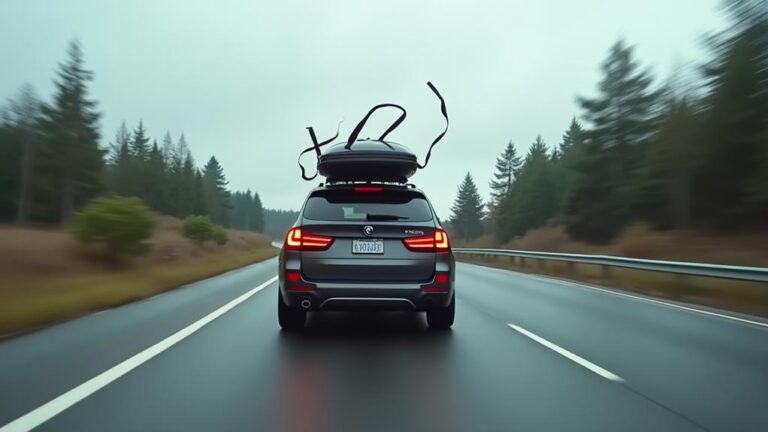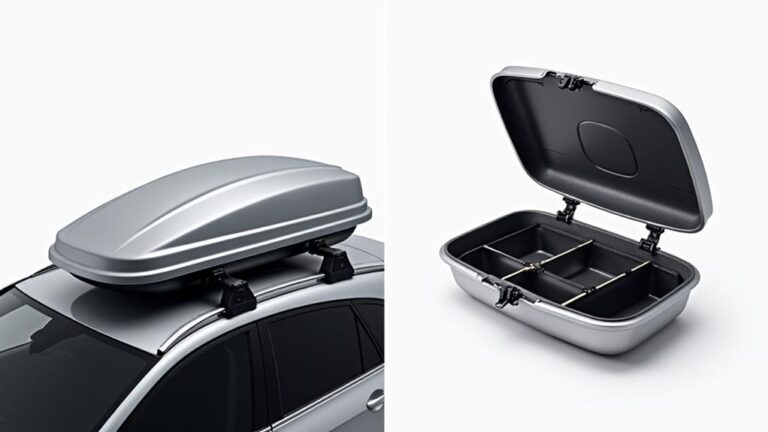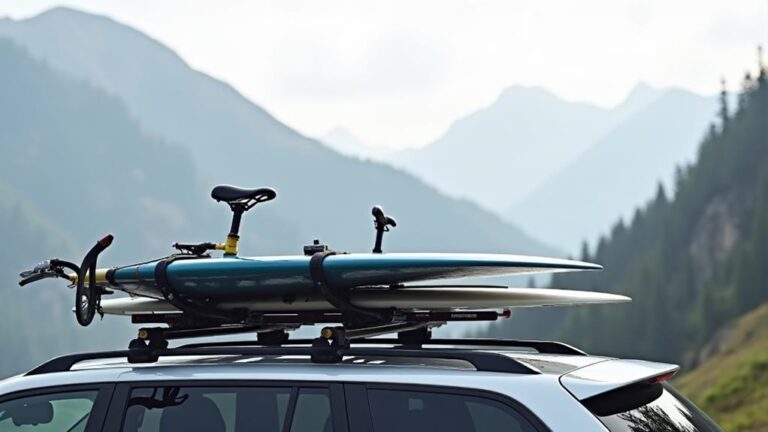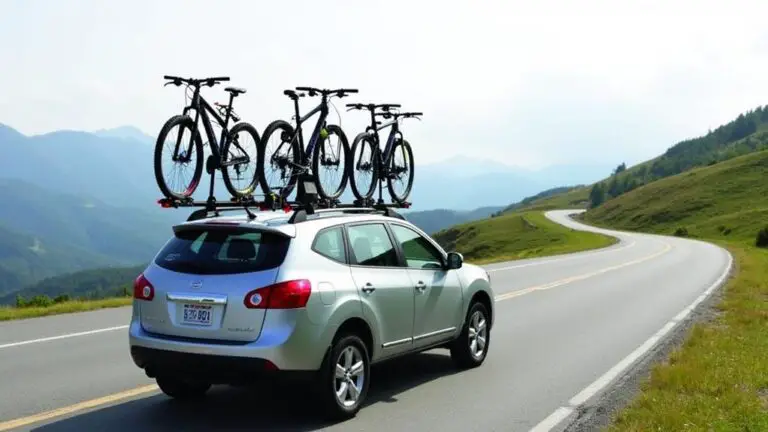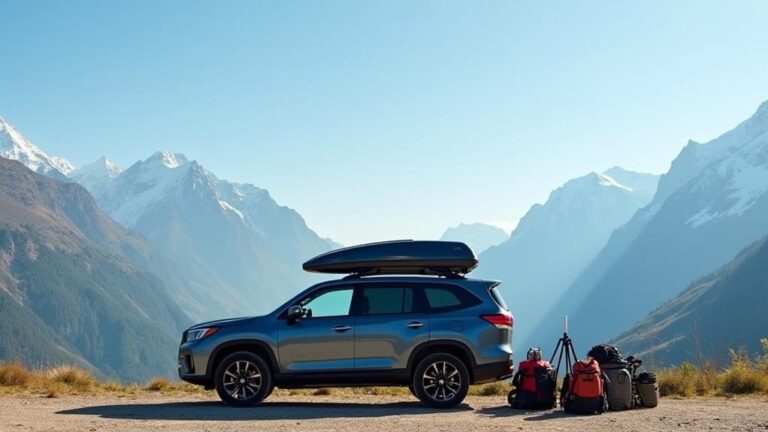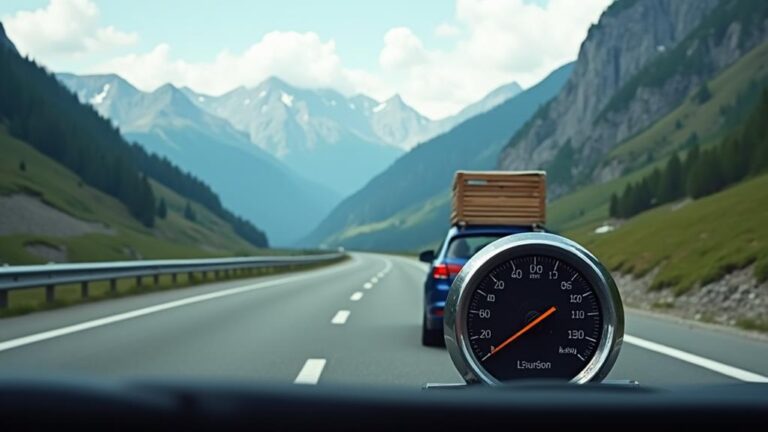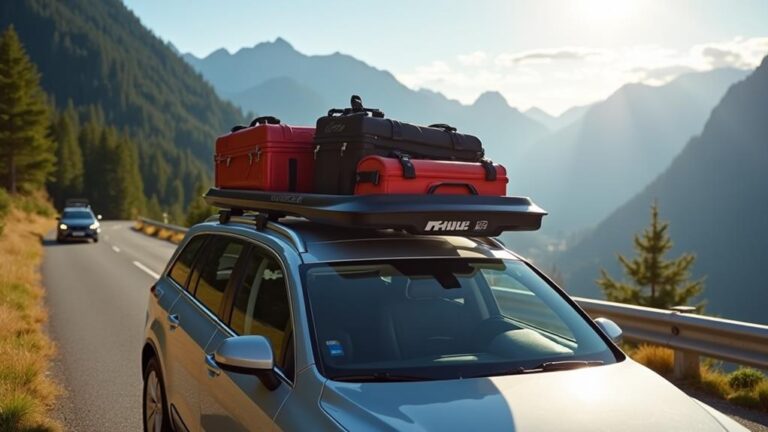You're likely familiar with the phrase "dead weight," but have you ever stopped to think about how it might apply to your car's roof box? Imagine driving down the highway with an empty roof box, its vacant space catching the wind like a sail, causing your vehicle to sway and potentially lose control. The unsettling truth is that this scenario is more common than you think, and it's putting drivers and passengers at risk. As you wonder about the real dangers of driving with an empty roof box, you might start to question: what exactly are the consequences, and how can you avoid them?
Key Takeaways
- Driving with an empty roof box poses risks to drivers and other road users due to increased wind resistance and swaying.
- An empty roof box compromises vehicle stability, putting drivers at risk of an accident, particularly at high speeds or in strong winds.
- High-speed travel with an empty roof box creates aerodynamic instability, generating lift forces that can destabilize the vehicle.
- Empty roof boxes disrupt airflow, affecting aerodynamic efficiency and increasing fuel consumption to overcome drag and maintain speed.
- Roof boxes can cause excessive wear and tear on the vehicle, particularly if not properly secured or removed, leading to potential damage and maintenance issues.
Empty Roof Box Risks
Driving with an empty roof box poses several risks to you and other road users. The box can create additional wind resistance, increasing the likelihood of swaying or loss of control, especially at high speeds or in strong winds.
This can compromise your vehicle's stability, putting you and other drivers at risk of an accident. Furthermore, an empty roof box can also contribute to noise pollution, as the wind rushing past the box can generate excessive noise.
In terms of insurance implications, driving with an empty roof box may affect your policy coverage. Some insurance providers may consider an empty roof box a contributing factor in an accident, potentially leading to higher premiums or reduced coverage.
Regular safety inspections are essential to mitigate these risks. Verify that your roof box is securely attached, and inspect it for damage or wear. Remove the box when not in use to minimize potential hazards and guarantee compliance with safety regulations.
Impact on Fuel Efficiency
When you drive with an empty roof box, you'll notice increased wind resistance due to the box's shape and position, which disrupts airflow around your vehicle.
This disruption affects your vehicle's aerodynamic efficiency, creating drag that your engine must work harder to overcome. As a result, your engine consumes more fuel to maintain speed, leading to decreased fuel efficiency and increased fuel costs.
Increased Wind Resistance
Frequently, an empty roof box can substantially impact your vehicle's aerodynamics, particularly from the standpoint of increased wind resistance. When you install a roof box, it's vital to weigh the aerodynamic design of both the box and your vehicle.
The box's shape and size can disrupt the airflow patterns around your vehicle, leading to increased drag. As you drive, air flows over and under your vehicle, creating an area of lower air pressure above the roof and a higher air pressure below. An empty roof box can interfere with these airflow patterns, creating turbulence and pockets of low air pressure that increase wind resistance.
When you're driving with an empty roof box, you may notice a slight decrease in your vehicle's performance. The increased wind resistance can cause your vehicle to work harder to maintain speed, which can lead to decreased fuel efficiency.
As you accelerate, the wind resistance can also cause your vehicle to consume more fuel to overcome the drag. Understanding the effects of increased wind resistance is vital in determining the overall impact of an empty roof box on your vehicle's performance and fuel efficiency.
Reduced Aerodynamic Efficiency
The aerodynamic design of your vehicle plays a significant role in maintaining its aerodynamic efficiency. When you drive with an empty roof box, this design is compromised.
The roof box creates turbulence as air flows over it, disrupting the smooth flow of air around your vehicle. This disruption leads to reduced aerodynamic efficiency, which can negatively impact your fuel efficiency.
As you drive with an empty roof box, you're creating drag that wasn't there before. This drag forces your engine to work harder, using more fuel to maintain your vehicle's speed.
The impact of reduced aerodynamic efficiency can be significant, especially on long road trips or when driving at high speeds.
Here are three ways an empty roof box can reduce aerodynamic efficiency:
- Increased drag coefficient: The roof box creates a larger frontal area, which increases the drag coefficient of your vehicle, leading to reduced aerodynamic efficiency.
- Disrupted airflow: The roof box disrupts the smooth flow of air around your vehicle, creating turbulence that reduces aerodynamic efficiency.
- Wind tunnel testing: Studies have shown that vehicles with roof boxes experience reduced aerodynamic efficiency in wind tunnel tests, highlighting the need to remove or cover the roof box when not in use.
Affecting Car Handling
Driving with an empty roof box can dramatically alter your car's handling dynamics. You might notice that your vehicle's behavior on the road changes, particularly when cornering or braking.
This is because the additional weight and aerodynamic drag of the roof box, even when empty, affect the car's overall weight distribution and center of gravity.
For sporty cars, which often have a lower center of gravity due to their design and weight distribution, an empty roof box can be particularly problematic.
The added weight and altered aerodynamics can disrupt the car's balance, making it more prone to understeer or oversteer when cornering. Similarly, electric vehicles, which typically have a lower center of gravity due to the placement of their batteries, can also be affected by the presence of an empty roof box.
In both cases, the changes in handling dynamics can make the vehicle more difficult to control, especially for inexperienced drivers. As you drive with an empty roof box, you may need to adjust your driving style to compensate for the altered handling characteristics of your vehicle.
Increased Noise Levels
Silence on the road is disrupted when you drive with an empty roof box, as the added structure creates turbulence that generates noise. This noise isn't only annoying but also affects your overall driving experience.
When you drive with an empty roof box, you'll notice an increase in vibration levels, which can be felt throughout the vehicle. This vibration contributes to the increased noise levels and can also impact the sound quality within the vehicle.
Here are three key factors that contribute to the increased noise levels when driving with an empty roof box:
- Wind Turbulence: The roof box creates a low-pressure area above it, causing the air to flow faster and create turbulence. This turbulence generates noise that resonates throughout the vehicle.
- Vibration Amplification: The empty roof box amplifies the vibration levels of the vehicle, which in turn increases the noise levels. This amplification occurs due to the structural properties of the roof box and its attachment to the vehicle.
- Resonance Effects: The empty roof box can also create resonance effects, where the noise generated by the wind turbulence and vibration amplification is amplified by the box's structural properties, further reducing the overall sound quality within the vehicle.
Potential for Damage
When driving with an empty roof box, you'll want to contemplate the potential for damage to your vehicle.
An empty roof box can cause excessive wear and tear on your roof, as the box's weight and position can put additional stress on the roof's mounting points and surrounding structure.
Additionally, the box's shape and size can alter your vehicle's drag and wind resistance, potentially leading to increased fatigue on various components.
Roof Wear and Tear
Your vehicle's roof can withstand a significant amount of stress from wind, weather, and external loads. However, driving with an empty roof box can still cause wear and tear, potentially leading to damage over time.
The repetitive stress of wind and road vibrations can weaken the roof's structure, making it more susceptible to cracks and rust.
To minimize roof wear and tear, it's vital to perform regular roof maintenance and inspection.
This includes:
- Checking the roof box mounting points: Verify that the roof box is securely attached to the roof, and the mounting points aren't damaged or corroded.
- Inspecting the roof for signs of damage: Look for cracks, rust, or dents that could be exacerbated by the empty roof box.
- Cleaning the roof and roof box: Regularly clean the roof and roof box to prevent dirt and debris from accumulating and causing damage.
Drag and Wind Resistance
Driving with an empty roof box also exposes your vehicle to increased drag and wind resistance. This occurs because the roof box itself creates turbulence and disrupts airflow around the vehicle.
As a result, the aerodynamic profiles of the vehicle are compromised, leading to increased air resistance. The increased drag can cause your vehicle to work harder, resulting in reduced fuel efficiency and potentially increased emissions.
Wind tunnel tests have shown that the shape and size of the roof box can greatly impact airflow around the vehicle. A roof box with a blunt or angular shape can create more turbulence than a streamlined one.
Additionally, the installation of the roof box can also affect airflow. A roof box that isn't properly secured or is installed at an angle can exacerbate the drag and wind resistance.
The increased drag and wind resistance can put additional stress on the vehicle's engine and transmission. This can lead to premature wear and tear on these components, potentially resulting in costly repairs.
Safety Concerns at High Speed
High-speed travel with an empty roof box poses significant safety risks due to aerodynamic instability and increased wind resistance.
As you drive at high speeds, the empty roof box creates areas of low air pressure above and behind it, generating lift forces that can destabilize your vehicle.
This aerodynamic instability can lead to reduced handling and responsiveness, making it more challenging to control your vehicle during emergency maneuvering.
The effects of high-speed dynamics on an empty roof box can be severe. Three key concerns are:
- Loss of traction: As your vehicle becomes unstable, you may lose traction, particularly when cornering or braking. This can lead to skidding or loss of control.
- Reduced maneuverability: The increased wind resistance and aerodynamic instability can make it more difficult to change direction or respond to emergency situations.
- Increased stopping distance: The additional drag created by the empty roof box can increase your stopping distance, making it more challenging to stop safely in emergency situations.
When driving at high speeds with an empty roof box, it's crucial to be aware of these risks and adjust your driving accordingly to minimize the potential for accidents.
Roof Box Regulations
Manufacturers and regulatory bodies have established strict roof box regulations to guarantee safe and efficient transportation. When you're considering purchasing a roof box, you should check for roof box certification.
This involves compliance with standards set by organizations like the European Car Roof Box Manufacturers' Association (ECMA) or Thule Test Center. These certifications guarantee that the roof box meets specific requirements, such as durability, wind resistance, and compatibility with various vehicle types.
You should also be aware of box weight limits. Roof box regulations dictate that the total weight of the roof box, including its content, shouldn't exceed a certain limit.
This limit varies depending on the vehicle's maximum roof load capacity. It's vital to follow these guidelines to avoid compromising the structural integrity of your vehicle's roof. Overloading your roof box can lead to accidents and injuries.
Always consult the manufacturer's guidelines and your vehicle's manual to guarantee compliance with these regulations. By adhering to these regulations, you can minimize the risks associated with driving with an empty roof box.
Removing the Roof Box
When you've finished using your roof box, removing it from your vehicle is a necessary step to maintain efficiency and safety on the road.
You can guarantee roof box security by following the correct box removal techniques.
Before you start, make sure you have the necessary tools and consult your vehicle's manual for specific instructions.
1. Loosen the mounting system: Start by loosening the mounting system that secures the roof box to your vehicle's roof rack.
This may involve turning a knob or releasing a latch.
2. Disconnect the electrical connections: If your roof box has any electrical connections, such as lights or sensors, disconnect them to prevent any damage or short circuits.
3. Lift the roof box carefully: Once the mounting system is loose and the electrical connections are disconnected, carefully lift the roof box off the roof rack and set it aside.
Frequently Asked Questions
Can Roof Boxes Be Used in Extreme Weather Conditions?
You should check your roof box's specifications, as some are designed to withstand extreme weather conditions. Aerodynamic issues may arise, so it's crucial to pass wind resistance tests to guarantee safe use in harsh weather.
Do Roof Boxes Void Car Manufacturer Warranties?
You're installing a roof box, but you're unsure if it'll void your car's warranty. Check your manufacturer's terms, as some may reject warranty claims or cause insurance issues if a roof box is incorrectly fitted or used.
Are Roof Boxes Compatible With All Car Models?
You'll find that roof boxes aren't compatible with all car models due to varying weight capacities and aerodynamic mismatch. Check your vehicle's specs to guarantee the roof box's weight and size won't compromise stability and safety.
Can Roof Boxes Be Locked for Security Purposes?
Ironically, you're worried about securing an empty space – your roof box. You can lock it using roof box keys and box locking mechanisms, providing an additional layer of security, deterring potential theft and tampering attempts.
Do Roof Boxes Require Special Cleaning Procedures?
When maintaining your roof box, you'll typically follow standard procedures. You'll wash the exterior and dry it thoroughly. For interior cleaning, you'll vacuum and wipe down surfaces with mild soap and water to prevent damage.
Conclusion
Driving with an empty roof box poses significant safety risks. According to the UK's Royal Society for the Prevention of Accidents, a roof box can increase fuel consumption by up to 15% even when empty. This isn't just a matter of efficiency; it also affects car handling, generates increased noise levels, and poses a risk of damage. Removing the roof box when not in use is vital to maintain safety and efficiency on the road.
